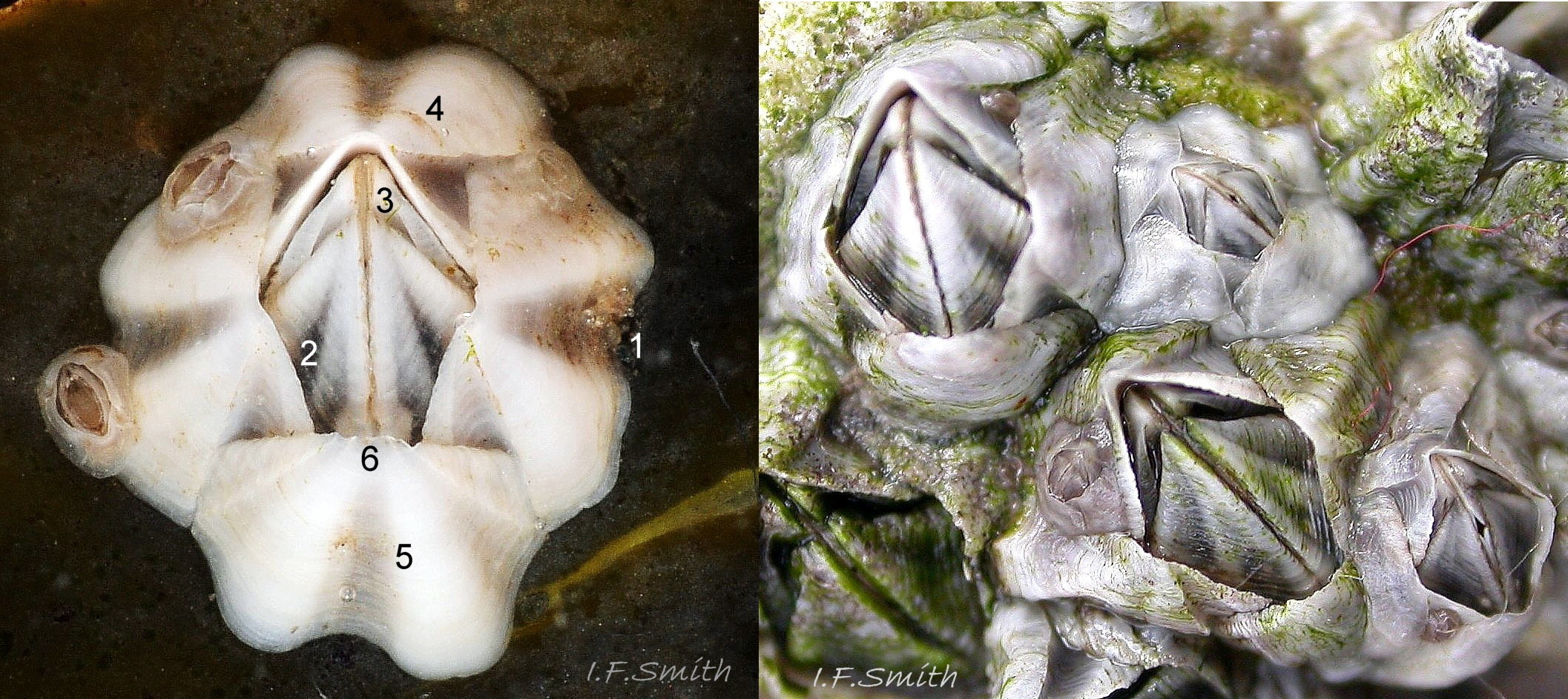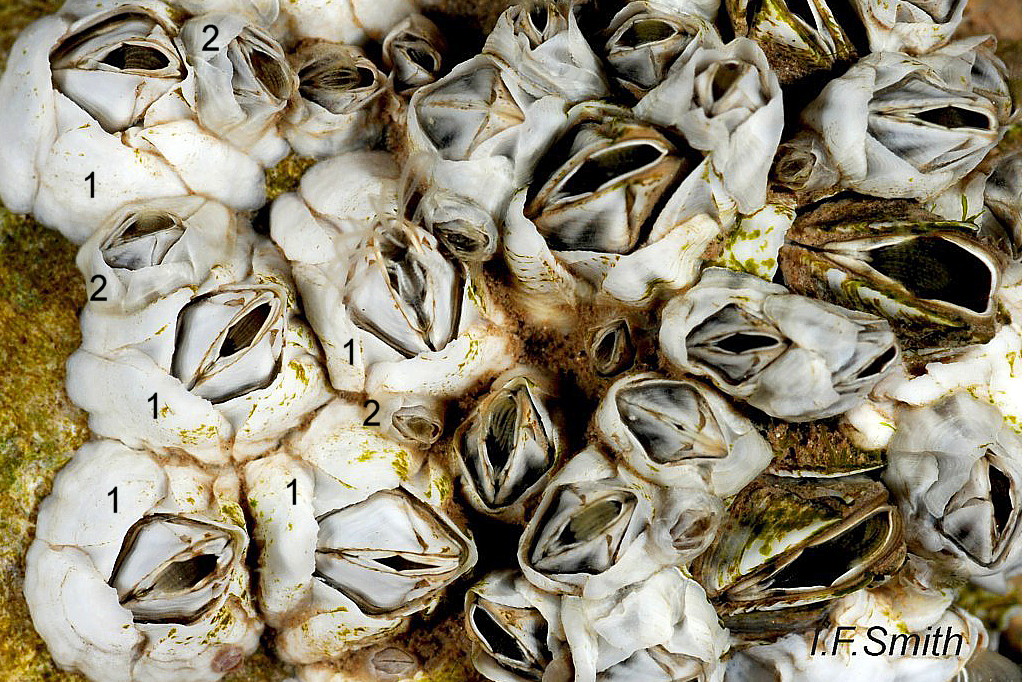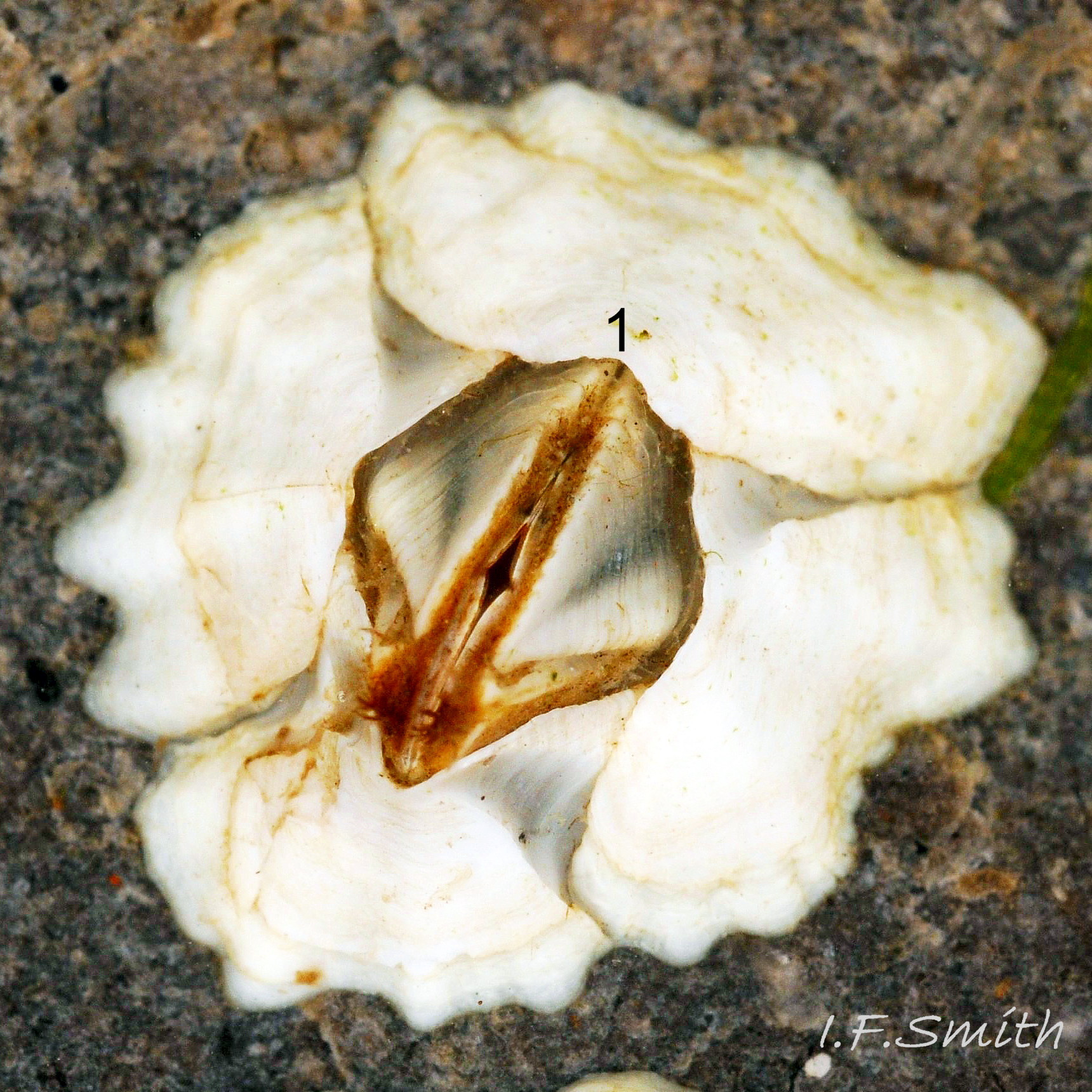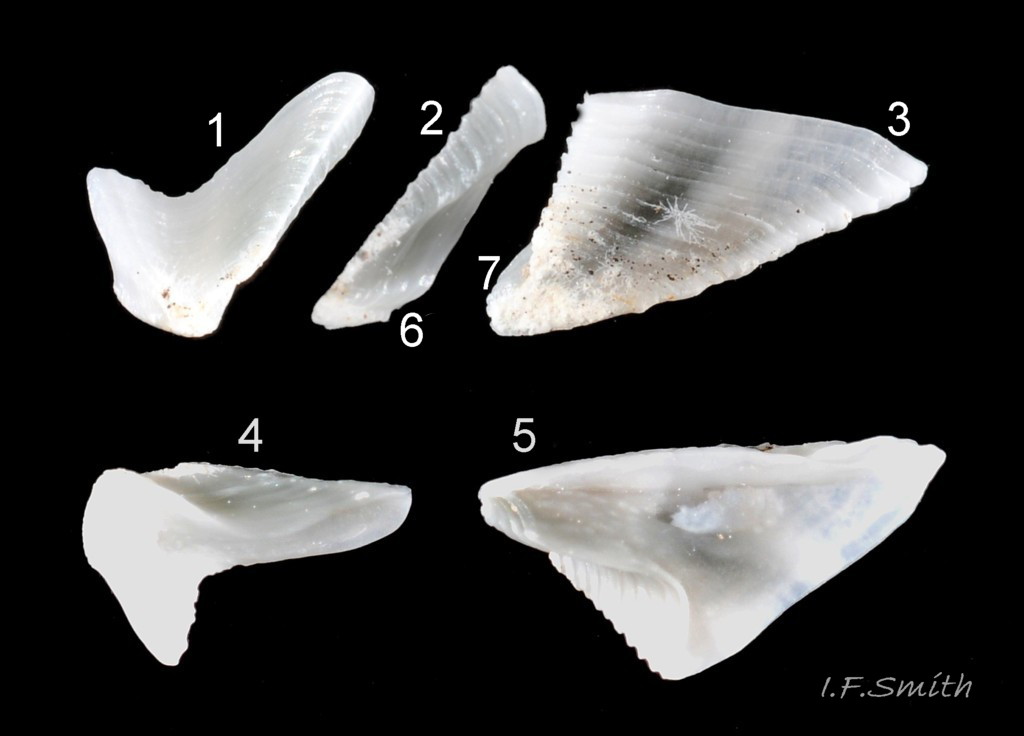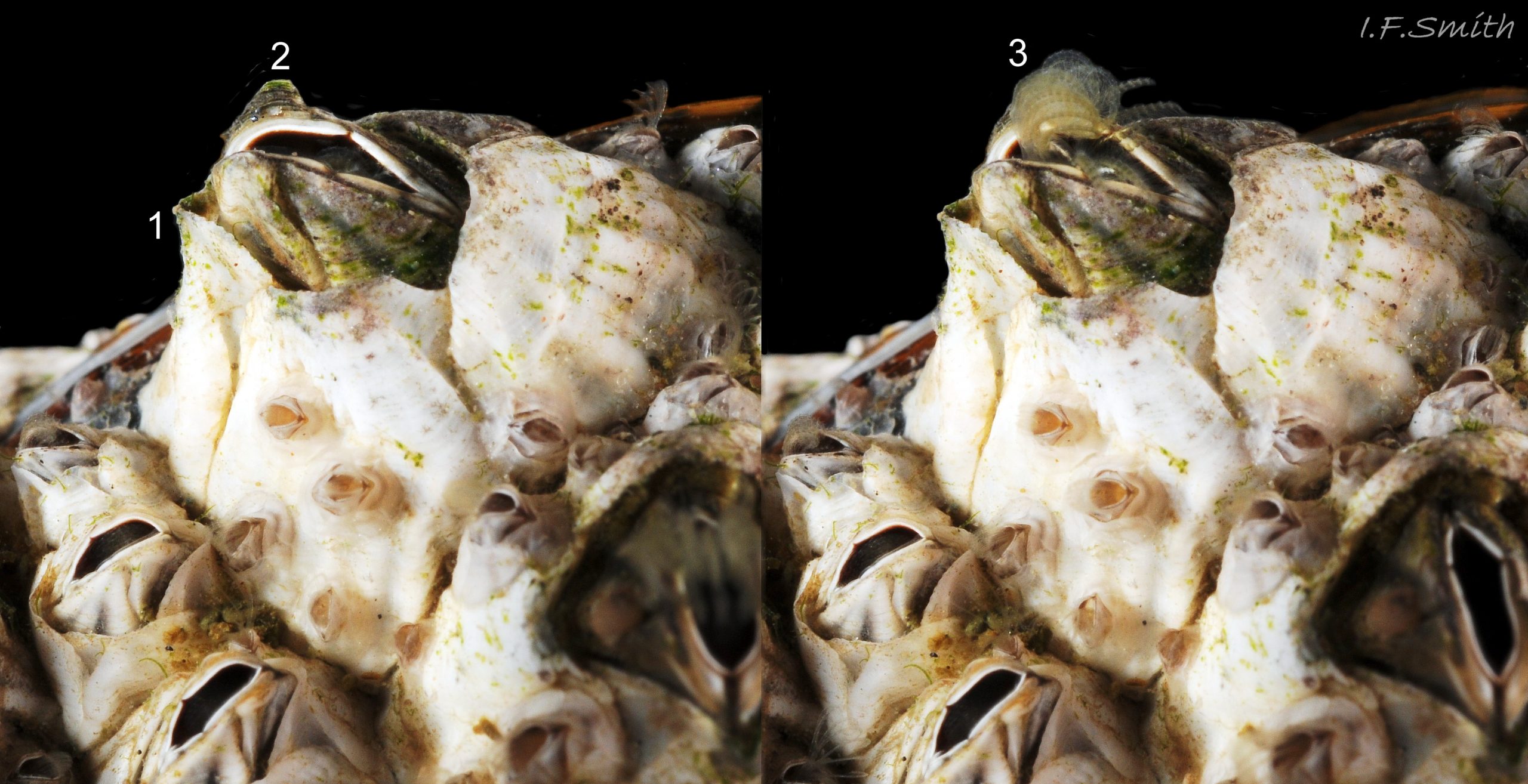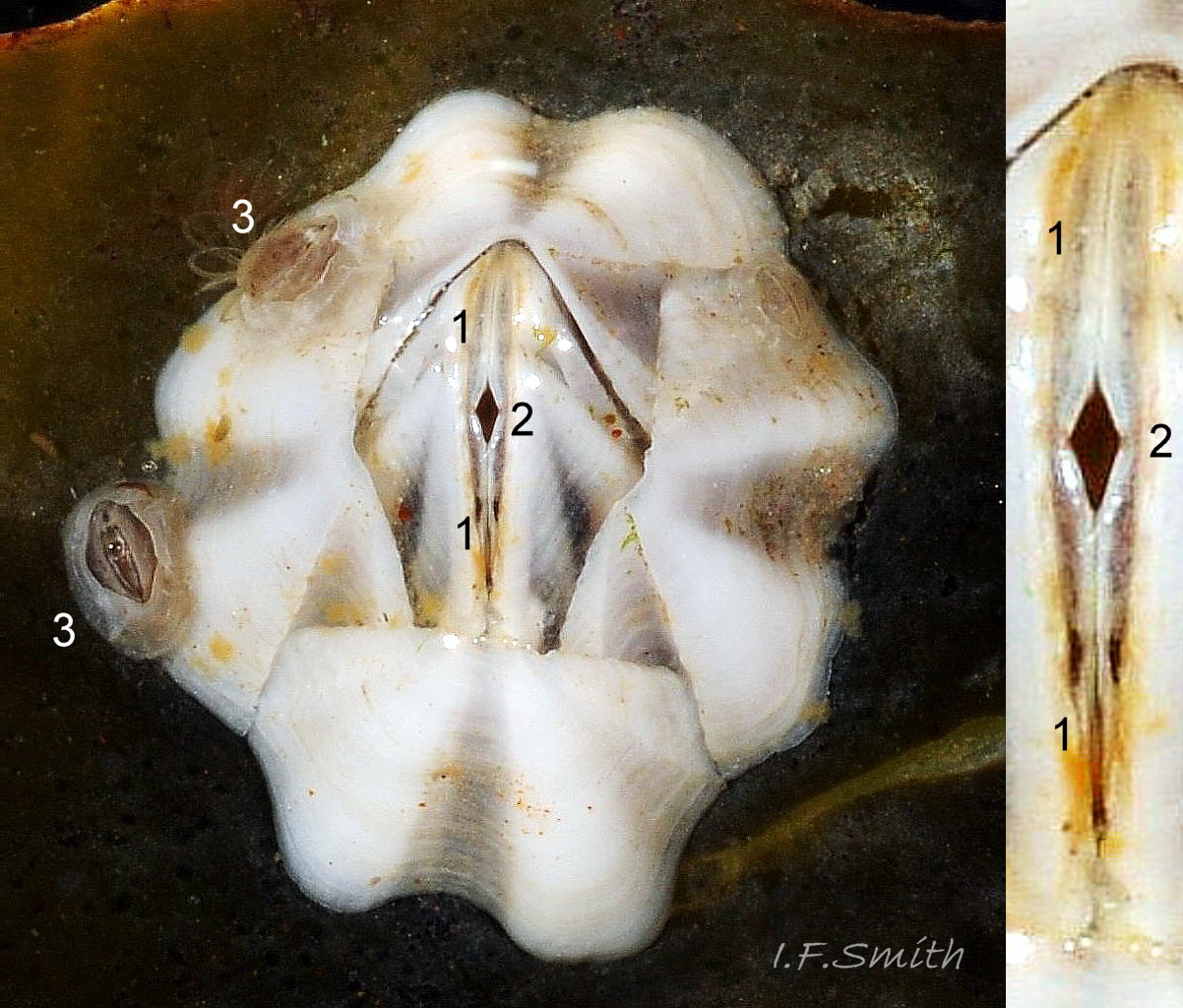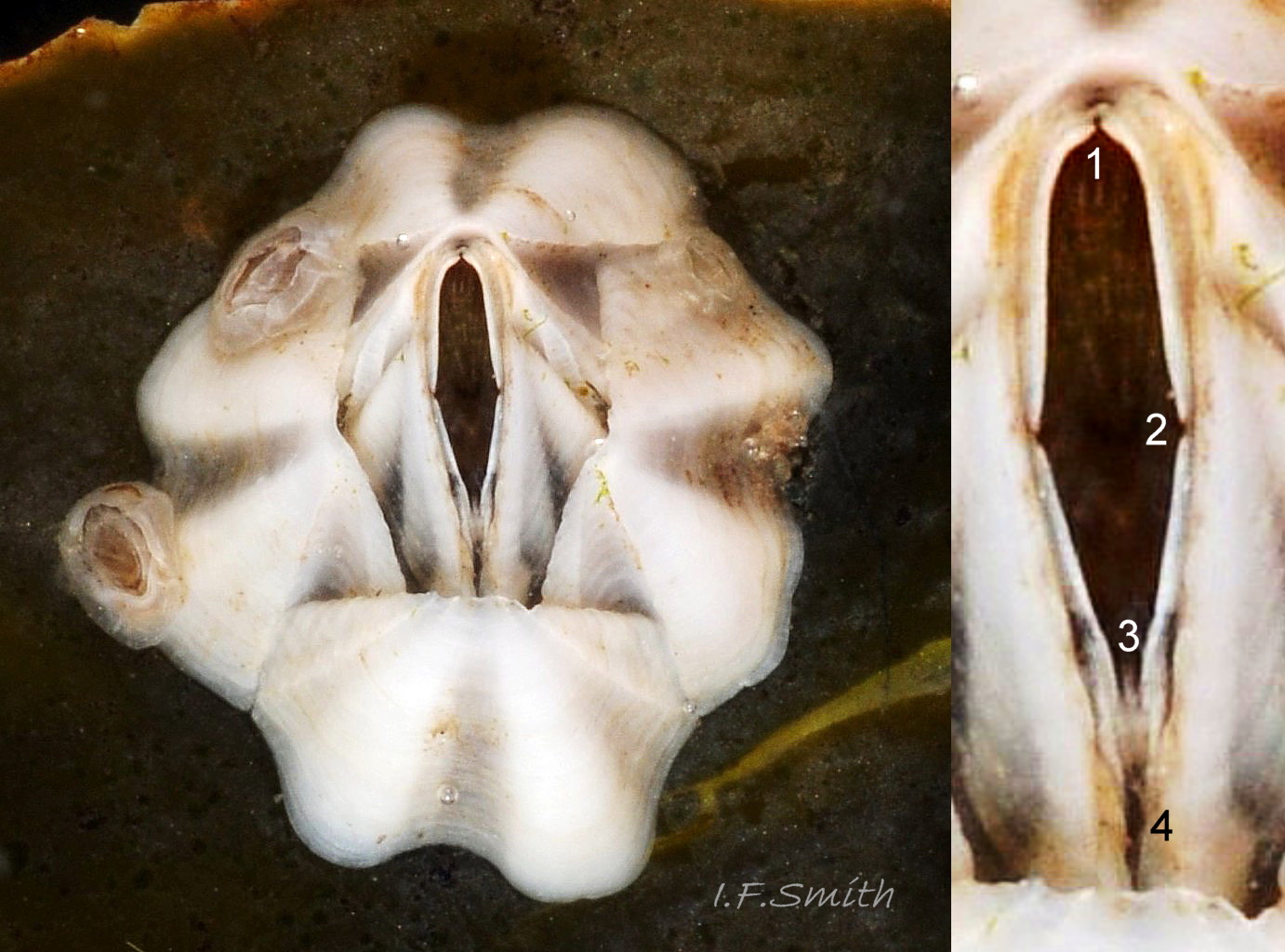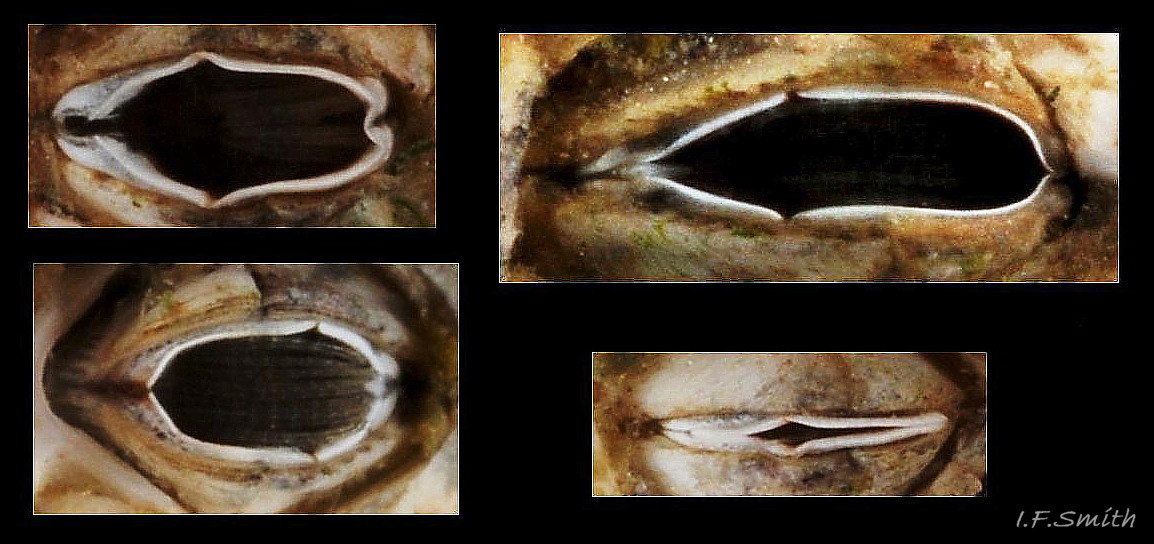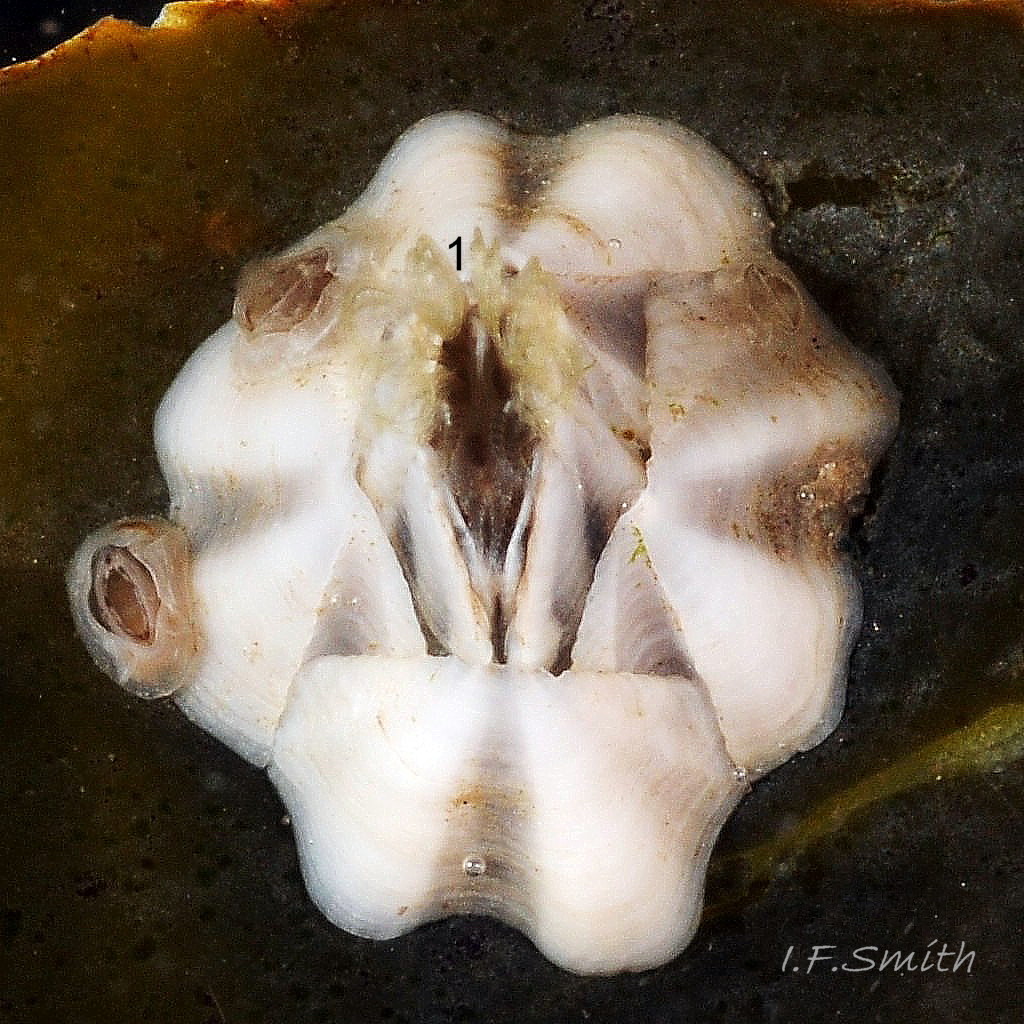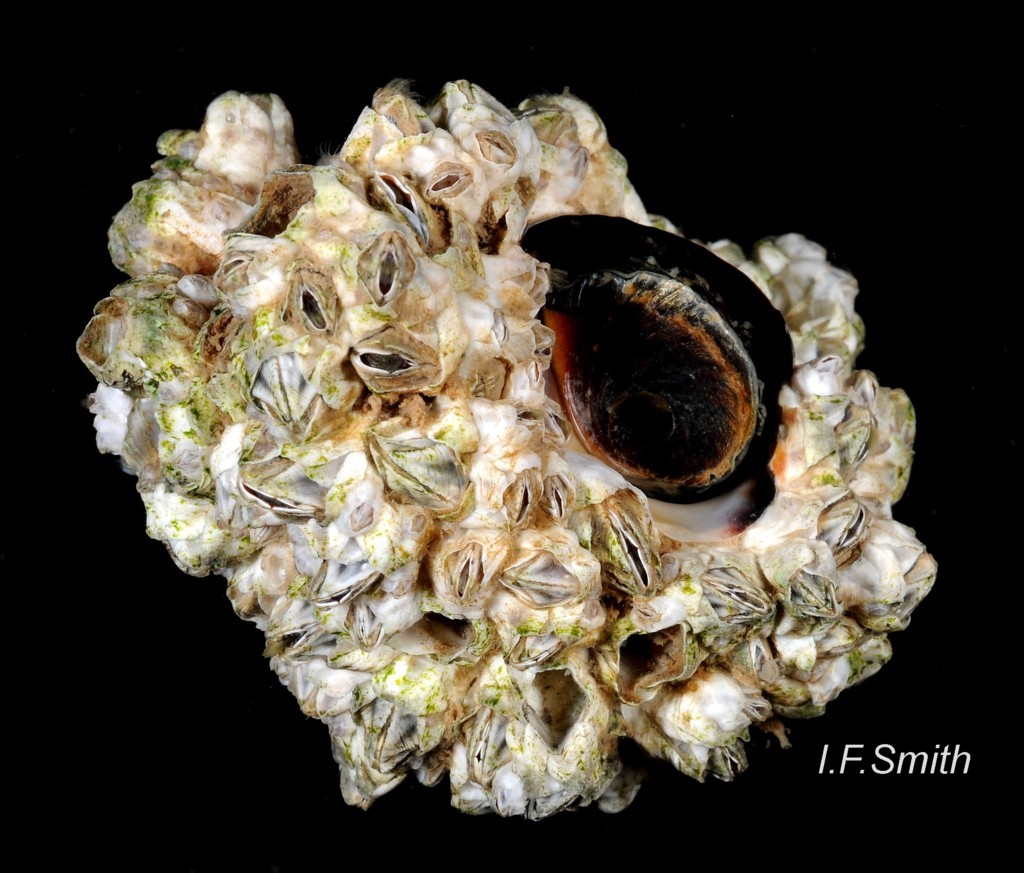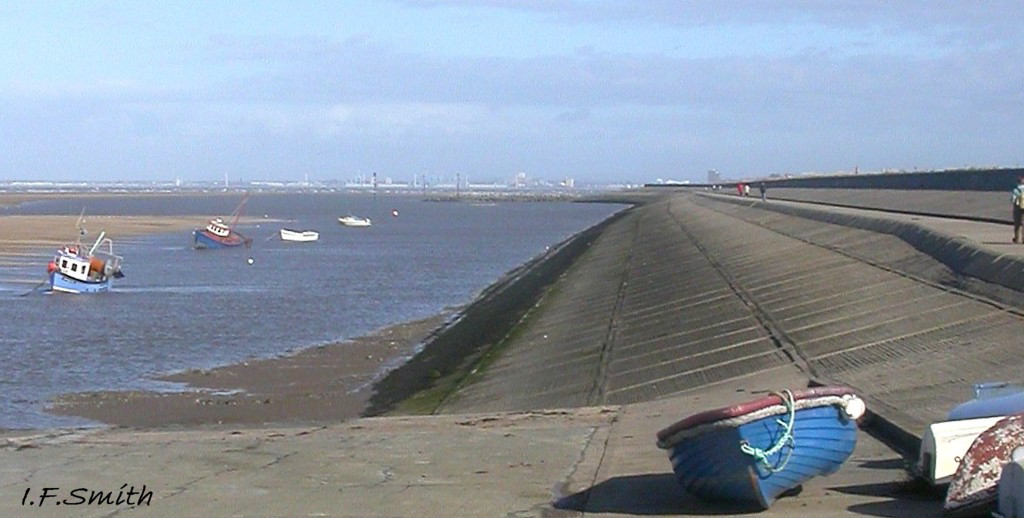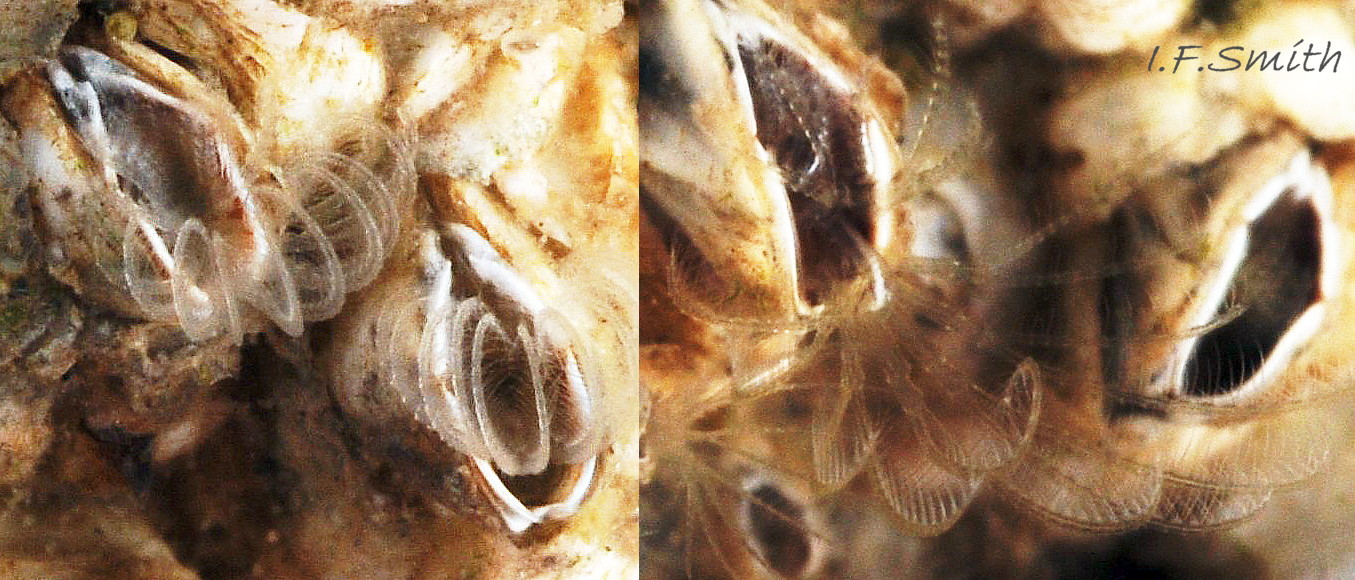Click image to enlarge with full caption. Main text below slider.
Austrominius modestus (Darwin, 1854). Text I.F. Smith
Current taxonomy; World Register of Marine Species www.marinespecies.org/aphia.php?p=taxdetails&id=712167
Recent synonym: Elminius modestus (Darwin, 1854)
Vernacular names: Australasian barnacle, New-Zealand barnacle, Modest barnacle (English); Crachen Awstralia (Welsh); Firepladet rur (Danish); Sterretje, Nieuw-Zeelandse zeepok, Kruisridderpok (Dutch); Balane de nouvelle, Balane croix de Malta (French); Neuseeländische Seepocke, Austral-Seepocke, Australische Seepocke (German).
GLOSSARY below
Description
The apical aperture has an acute angle at the carina ( 01 Austrominius modestus ). It is a diamond shape when the angle at the rostrum is also acute (02 Austrominius modestus ); a blunt diamond shape when the rostrum edge is indented (03 Austrominius modestus ); and a pentagon when the rostrum edge is flat (01 Austrominius modestus“>01 Austrominius modestus ). It has an operculum (lid) of four valves, two terga and two scuta, which open along a longitudinal midline with a tergum and scutum each side (01 Austrominius modestus ). The scutum has distinct, but not strongly ridged, growth lines, and thin blackish triangle when not eroded. When the valves are shut, a cavity is visible in the tergum which accommodates a protrusion of the scutum (04 Austrominius modestus ).
The tergoscutal flaps (tissue on the dorsal edges of the opercular valves) have a wide white rim followed by grey further into the barnacle. When viewed obliquely, the interior of adults may be brown (05 Austrominius modestus ) but, often, only the wide white rim is visible. A micropyle is often visible when the operculum is shut (06 Austrominius modestus ). The flaps have a dark mark at each end, by the micropyle and mid-way between the micropyle and rostral end (07 Austrominius modestus & 08 Austrominius modestus ). When the valves are not fully open, some marks may not be visible, especially at the carinal end (06 Austrominius modestus ).
When young, the four white wall plates each have a grey central furrow and form a Maltese cross in outline (01 Austrominius modestus ). Older specimens often lose the grey furrows and Maltese cross outline (03 Austrominius modestus ), but the diagnostic distinct four wall plates (as opposed to six on other species) are usually distinguishable unless concealed by crowding neighbours (02 Austrominius modestus ).
The profile is low when uncrowded (09 Austrominius modestus ). When crowded, the profile may become higher (05 Austrominius modestus ), but not columnar, and they may clump into a ball (10 Austrominius modestus ).
The base of A. modestus is membranous, so no calcareous plate is left on rock when the barnacle removed. The diameter of the base is up to 10 mm.
Key identification features
For most species of Acorn barnacles, the tergoscutal flaps are the most reliable features for identification but, because the flaps of A. modestus and Semibalanus balanoides are so similar, they should be differentiated by their numbers of wall plates as A. modestus usually retains distinct sutures (except when concealed by crowding neighbours).
Austrominius modestus
1) Wall plates: Only species of acorn barnacle in British waters with 4 distinct wall plates (01 Austrominius modestus ). (Verruca stroemia has 4 indistinctly delineated irregular wall plates).
2) Tergoscutal flaps: White rim has dark mark at each end, by micropyle and mid-way between micropyle and rostral end (07 Austrominius modestus ).
3) Base plate: No calcareous plate.
4) Tide level: All tide levels.
5) Salinity: Fully marine to weakly brackish, including tidal rivers.
Similar species
Semibalanus balanoides (Linnaeus, 1767)
1) Wall plates: six.
2) Tergoscutal flaps: Similar to A. modestus (02 Austrominius modestus ).
3) Base plate: No calcareous plate.
4) Tide level: Commonest around mid-tide level, but occurs to mean high water neap and on lower shore.
5) Salinity: Fully marine to brackish outer estuaries, not inner estuaries or tidal rivers below about 20 ‰.
Balanus crenatus Bruguière, 1789
(11 Austrominius modestus album. COMPARISON images of Balanus crenatus. )
1) Wall plates: six.
2) Tergoscutal flaps : Bright yellow or white, with longitudinal brown ribbon.
3) Base plate: calcareous with “web” of radial and concentric lines when fresh.
4) Tide level: lower shore.
5) Salinity: fully marine, or nearly so.
Habits and ecology
A. modestus has a wide environmental tolerance and out-competes other barnacles in some habitats (02 Austrominius modestus ). It is not common where wave action is very strong as its shell is relatively weak. It is more tolerant of turbidity and adhering sediment than other British barnacles (Lewis, 1964), except Amphibalanus improvisus (Darwin, 1854) (12 Austrominius modestus ). It prospers on a diet of diatoms and/or flagellates swept from the water by its cirri (13 Austrominius modestus ); most species require one or the other (Green, 1968). It is euryhaline; on estuaries it displaces Amphibalanus improvisus at all except the very lowest salinities. It has yet to occupy the brackish inner Baltic, perhaps because of very cold winters, where euryhaline A. improvisus still dominates.
Though sensitive to hard frosts, its breeding is eurythermic. It mates at, and above, 6°C, and ova develop at 3 to 32°C (Green, 1968), so it breeds in all months in Britain and Ireland (Southward, 2008), with a peak from May to October. Its multiple generations per annum enable its larvae to occupy vacant space before other species can settle (Lewis, 1964). It can mature in eight weeks and has a lifespan of 12 to18 months. Settles on weed and any hard substrate, including barnacles of its own and other species at all tide levels and sublittorally and it often displaces other species by overgrowing them (02 Austrominius modestus ).
Distribution and status
A. modestus is native to New Zealand, Tasmania and south-eastern Australia. It was introduced to England on military vessels during World War II. GBIF map www.gbif.org/species/2115769 . It now occurs from Denmark to southern Portugal and is widespread in Britain and Ireland, though less common in parts of Scotland. UK map species.nbnatlas.org/species/NHMSYS0021006592
References & links
Green, J. 1968. The biology of estuarine animals. London.
Lewis, J.R. 1964. The ecology of rocky shores. London.
Rainbow, P.S., 1984. An introduction to the biology of British littoral barnacles.
fsj.field-studies-council.org/media/350581/vol6.1_161.pdf
Smith, I.F., 2015. Introduction to Barnacle Morphology & Identification. (PDF) DOI: 10.13140/RG.2.1.4006.3527
www.researchgate.net/publication/275464262_Introduction_t…
Southward, A.J., 2008. Barnacles. London, Linnean Society.
GLOSSARY
‰ = parts per thousand (of salt in water).
ala = (pl. alae) side flange of wall plate, overlapped by radius of next plate.
carina = posterior wall plate adjoining the smaller pair of lid valves (terga).
carinal = (adj.) of the carina.
cirri = (sing. cirrus) feather-like thoracic limbs used in filter feeding.
cypris = (pl. cyprids) final larval bivalved stage in barnacle development.
euryhaline = tolerant of wide range of salinities.
eurythermic = tolerant of wide range of temperatures.
HW = high water level.
HWS = level of high water spring tide.
lateral plates = wall plates other than end plates (depending on sp., strictly may be rostro-lateral or carino-lateral).
left = on left when barnacle viewed from above with rostrum at 12 o’clock.
LWN = level of low water neap tide.
micropyle = small breathing/sensing hole between tergoscutal flaps, sometimes visible when operculum shut. Found on species that are left out of water for long periods.
MHW = mean high water.
MLWS = level of mean low water spring tide.
MTL = mid-tide level.
opercular = (adj.) of the operculum (aperture lid).
operculum = moveable lid-like set of valves used to close the aperture.
paries = ( pl. parietes) central section of wall plate, flanked by alae and radii.
radius = (pl. radii) side flange of wall plate, overlaps ala of adjacent plate.
right = on right when barnacle viewed from above with rostrum at 12 o’clock.
rostral = (adj.) of the rostrum.
rostrum = anterior wall plate adjoining larger pair of lid valves (scuta). (Lost on Austrominius and balanoids; place taken by fused rostro-laterals; referred to as rostrum for simplicity.)
scuta = (sing. scutum) the larger valves of the operculum (lid).
sessile = (adj.) permanently attached to substrate (of immobile organism).
stenohaline = unable to tolerate much variation in salinity.
terga = (sing. tergum) the smaller valves of the operculum (lid).
tergoscutal flaps = membranous “lid seals”, (most visible as valves start to open).
